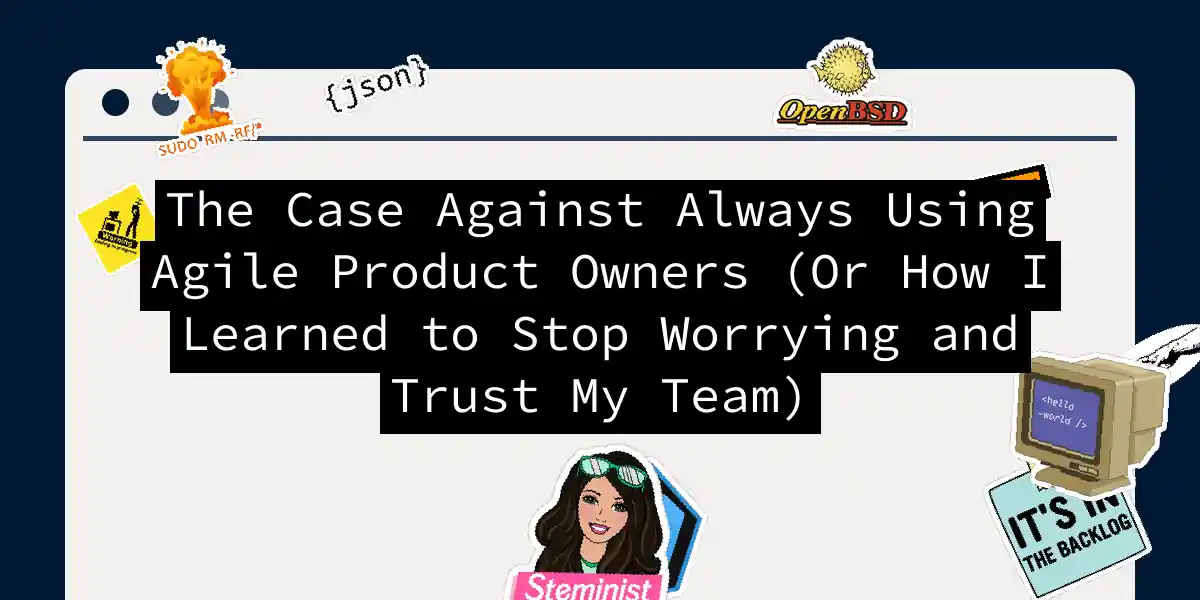Why Your Product Owner Might Be Your Newest Bottleneck
Let me paint you a picture: you’re at a sprint planning meeting watching your Product Owner argue with developers about database sharding strategies while the actual users haven’t seen a new feature in months. The JIRA board looks like a Jackson Pollock painting, and the only thing growing faster than the backlog is the team’s collective eye-roll. Congratulations - you’ve entered the Product Owner Twilight Zone.
The Cult of the PO-ssiah
Modern Agile practice often treats Product Owners like human Swiss Army knives:
- 🔧 Technical translator
- 🎯 Backlog janitor
- 🔮 Requirements soothsayer
- 🛡️ Stakeholder meatshield But here’s my hot take: We’ve created a single point of failure that would make Franz Kafka proud. Let’s dissect this with some code samples and battle-tested alternatives.
When PO-ssession Goes Wrong: Common Anti-Patterns
1. The Architecture Astronaut PO
class ProductOwner:
def __init__(self):
self.technical_debt_obsession = True
self.business_value_understanding = False
def prioritize_backlog(self):
return sorted(self.features, key=lambda x: x.cool_tech_factor, reverse=True)
(Inspired by 5+ enterprise POs I’ve cried with at conference bars) From the trenches: A client’s PO delayed a critical payments feature for 6 months optimizing an event-driven architecture that handled 10x their actual traffic needs.
2. The Backlog Hydra
Actual flow from a fintech startup’s “Agile” process
The Great Escape: Alternative Models That Actually Work
Option 1: The RACI Rebellion
| Role | Requirements | Tech Design | QA Strategy |
|--|--|--|--|
| Lead Developer | C | A | R |
| UX Designer | A | C | I |
| Customer Success | R | I | I |
(R=Responsible, A=Accountable, C=Consulted, I=Informed - adapted from ) A financial services team reduced cycle time by 40% using this approach, with developers directly accountable for technical decisions.
Option 2: Pair Programming with Reality
# Team decision-making protocol
while [ !$FEATURE_DELIVERED ]; do
dev_pair = select_developers --skill-frontend --skill-backend
customer_rep = find_user --role=actual-paying
make_decisions --participants $dev_pair $customer_rep | tee /prod/reality_check.log
done
Actual script used by a SaaS company to bypass PO-induced hallucinations
Your Anti-PO Survival Kit
Step 1: The “Should We PO?” Checklist
- Does this require daily technical arbitration? ➔ Maybe need PO
- Are we building for engineers or customers? ➔ Warning sign!
- Can we map decisions to RACI? ➔ Try that first
- Is the team senior enough to own outcomes? ➔ Democracy beats PO-cracy
- Are we optimizing for resume-building vs shipping? ➔ Red alert! (Informed by 10+ org transformations )
Step 2: The Stakeholder Taming Protocol
True story from a retail analytics platform - saved 3 months of PO-mediated negotiations
When You Actually Need a Product Owner
- Regulatory Complexities (Healthcare/Fintech)
- Enterprise Sales-Driven Roadmaps
- Massively Parallel Development Streams
- Junior Team Maturation Phase Even then, implement strong countermeasures:
def neuter_po(original_po):
original_po.technical_decision_power = False
original_po.feedback_cycle = ContinuousIntegrationSystem()
return original_po.constrain(scope=BusinessValidityCheck)
The Path Forward: Beyond Dogma
As I once told a CTO who insisted on hiring their 7th PO: “You can’t agile your way out of organizational learned helplessness.” The best teams I’ve seen:
- Treat POs as option not requirement
- Measure value delivered, not backlog velocity
- Build technical/business T-shaped skills
- Put real users in the decision chain So next time someone insists you need a Product Owner, ask: “Is this solving our problem or just making ScrumBut soup tastier?” Your team’s sanity will thank you. Exceptional cases make bad dogma. Now go ship something. 🚀
